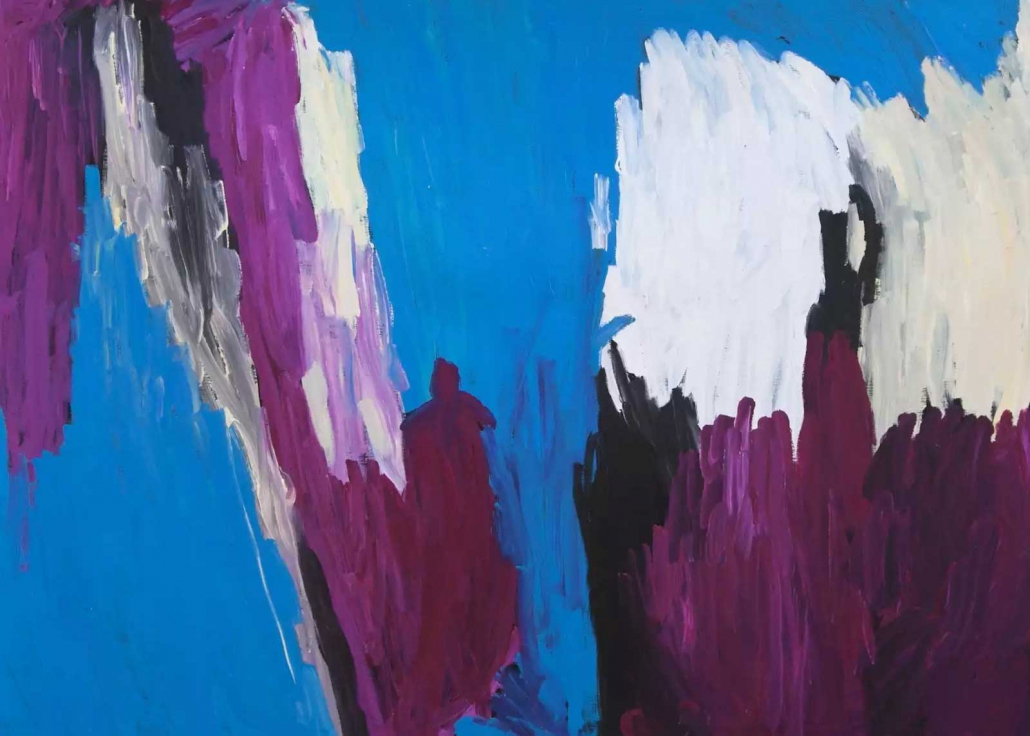Sally Gabori, ‘Dibirdibi Country’, 2012. Synthetic polymer paint on linen.
‘New stories of Creation (what’s the Word …?)’
Bible study prepared by Andrew
September 2021
Key text: John 1:1-14
John 1:14: “And the Word became flesh … we saw the Word’s glory (doxa) …”
Themes: Creativity, world, word/speech, wind/breath/spirit, embodiment, diversity, goodness, glory, non-violence (“grace and truth”) …
Readings
Genesis 1:1-5ff: “In the beginning (bereshit/genesis) God created the heavens and the earth … the Spirit of God (“mighty wind” or “breath of God”) was brooding over the surface of the waters … Then God said, ‘Light: Be!’ and light was. God saw that light was good …”
1 John 1:1 “That which was from the beginning (archē), which we have heard, and seen with our eyes, and have looked at and touched with our hands: the Word (logos), who is Life …”
Mark 1:1 “The gospel of Jesus Christ, God’s own, begins (archē) …”
Luke 1:2 “… exactly as those happenings were passed on to us by the original (archē) eyewitnesses and ministers of the Word (logos) …”
Definitions
Word/Logos (logo!) means Cosmic Principle, Reason (Gk); Wisdom/Sophia, Torah (Hb) …
Flesh/sarx/basar means physical/material being, living matter …
Artworks (by contemporary Australian landscape painters)
Catherine Cassidy, ‘Rain at Sea’, 2015. Vinyl and synthetic polymer paint and spray enamel.
Catherine Cassidy, ‘Big Cloud’, 2017. Vinyl and synthetic polymer paint and spray enamel.
Catherine Cassidy, ‘Reverse Pixie’, 2014. Synthetic polymer on French handmade paper.
Idris Murphy, ‘Kimberley Luminosity’, 2017. Synthetic polymer paint on board, 40 x 40cm.
Idris Murphy, ‘Forest Scotland Series 4’, 2014, 21 x 30cm.
Queenie McKenzie, ‘Limestone Hills near Texas Downs’, 1991.
Sally Gabori, ‘Dibirdibi Country’, 2012. Synthetic polymer paint on linen.
Introduction
In the New Testament, new stories of creation (the good news is both new and good) abound (see 1 John 1, Mark 1, Luke 1 …). John’s gospel, John’s new story of creation, is strongly incarnational (exploiting and critiquing/deconstructing dualism).
Incarnation reaffirms/renews a sacramental worldview; the interplay of spirit and matter, divinity and humanity …
In Jesus – his person, body and blood, signs and works, the story/parable of his life, his community of friends (the example and pattern of “grace and truth”) – something glorious is seen … heard, touched, tasted (“munched”) … Readers/hearers are invited to believe and to participate.
Elsewhere, Jesus tells a parable about the Word as Seed (Matthew 13:1-23, Mark 4:1-20, Luke 8:4-15; see also Gospel of Thomas).
(1) Possible (ecological) interpretation: The Word/Seed became flesh – the flesh of fruit and vegetables, plants and animals, including human beings …
While not a theological work per se, the following is replete with theology.
Philosopher Emanuele Coccia’s The Life of Plants (2017/19) describes the world as the site of a metaphysical mixture. As the very creator of atmosphere, plants occupy the fundamental position from which we should analyse all elements of life.
“The origin of our world is in leaves: fragile, vulnerable, yet capable of returning, of coming back to life once they have passed through the rough season” (E. Coccia). [Gospel resonance?]
“[E]very truth is connected to every other truth, in the same way in which every thing is connected to every other thing. Besides, this connection – this universal conspiracy of ideas, of truths, and of things – is what we call world: what we cross and what crosses us each moment, each time we breathe” (E. Coccia). [Gospel resonance?]
(2) Possible (cross-cultural) interpretation: The Word/Vibration became life – becomes, creates. The Hum becomes/inhabits song …
“In the Bible … we are told, ‘In the beginning was the Word, and the Word was with God, and the Word was God’. And in the koan Aji-kwan from Roshi Bernie Glassman’s 200 Miscellaneous Koans, we learn that A is not just the first letter of the alphabet but the beginning of growth, the very source of the universe, the Tao itself. In these cases, there is no separation between language and the thing it represents. It is the thing itself. In the beginning was the Word, true expression, the great primeval sound, OM, Ahhhh, Mu, the very hum and vibration of creation itself, and it doesn’t mean anything, it doesn’t point to anything, it just is” (Taylor Plimpton, ‘Dharma Talk’, Winter 2017).
The Hum becomes elemental, becomes habitat …
Another philosopher refers to “the flesh of the world”.
See Maurice Merleau-Ponty’s concept of “flesh” as “the mysterious tissue or matrix that underlies and gives rise to both the perceiver and the perceived as interdependent aspects of its spontaneous activity,” and he identifies this elemental matrix with the interdependent web of earthly life (D. Abram, D. The Spell of the Sensuous: Perception and Language in a More-than-Human World. Pantheon Books, New York, 1996).
This concept unites subject and object dialectically as determinations within a more primordial reality, which Merleau-Ponty calls “the flesh”, and which Abram refers to variously as “the animate earth”, “the breathing biosphere”, or “the more-than-human natural world”.
Thirdly, we might consider becoming flesh as embodiment, integrity, practice.
(3) Possible (existential/practical) interpretation: A word becomes flesh when we put it into practice. A word or value becomes flesh when it aligns with the life of a person, community or tradition. Jesus puts Torah into practice; lives out the “grace and truth” of the Trinity.
“St James, repeating a teaching of Jesus, puts it simply: ‘Let your yes be yes, and your no, no.’ We might develop this a little: Let your greeting be a warm greeting, let your sorry be a heartfelt sorry, let your goodbye be goodbye, and so on … The spiritual … has to do with integrity – with a coming to our senses, with a coming home to ourselves … Christianity, at its best, affirms relationship, non-duality, unity in diversity” (https://southsydneyherald.com.au/let-your-yes-be-yes/).
Four levels of interpretation (after Dante Alighieri)
- Literal (What is happening in the text/story?)
- Allegorical (What other texts/stories are called to mind?)
- Moral (How, then, shall we live?)
- Mystical (Which word/wisdom brings life to the world?)
Read the following comments on John 1:1-14 and assign each to one or more of the “levels”. What further questions are raised for you?
- “Whereas once the tabernacle in the desert and later the temple in Jerusalem became the dwelling place of God’s glory, in the incarnation of the Word that dwelling place is to be found in the ‘flesh’ or body of Jesus” (Brendan Byrne SJ).
- “I’ve read in the scriptures that the word of God is like a seed. Why? A seed you cast it to the wind and it multiplies. And we eat from it. So this word should be multiplied in us. And produce a food. And we should share that food” (Marcelino, Gospel in Solentiname).
- “[T]he central paradox of [John’s] gospel is that the logos crosses the divide and radically enters the domain of ‘flesh’: born yet not born, carnal yet spiritual, weak yet strong, dying yet living” (Tertullian, early Christian apologist and a polemicist against heresy, including contemporary Christian Gnosticism).
- “To create and to speak is the same thing. To create is a way of communicating. In creating you make something known, like when you write a poem or a song … or when a carpenter makes a table. Every worker becomes known through his/her creation …” (Antidio, Gospel in Solentiname).
- “The doxa is not to be seen alongside the sarx, not through the sarx as through a window; it is to be seen in the sarxand nowhere else” (C.K. Barrett).
- “The Word is now the people. It’s the people that do the work of God” (Felipe, Gospel in Solentiname).
Songs (thanks to Danielle)
Ben Lee’s ‘Giving Up On Miracles’ which speaks to the idea that we should give up on the idea of God appearing in miracles that work without our agency because God is already found in the everyday: https://www.youtube.com/watch?v=RKfxRNw-S8Q
Sinead O’Connor’s ‘The Healing Room’ which speaks about the Creator as intimately within: https://www.youtube.com/watch?v=ZPOQEjjevdk




